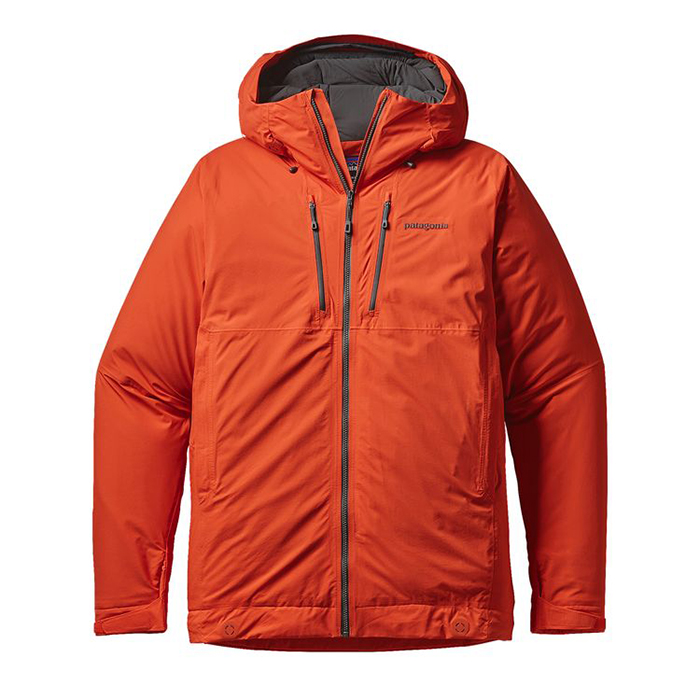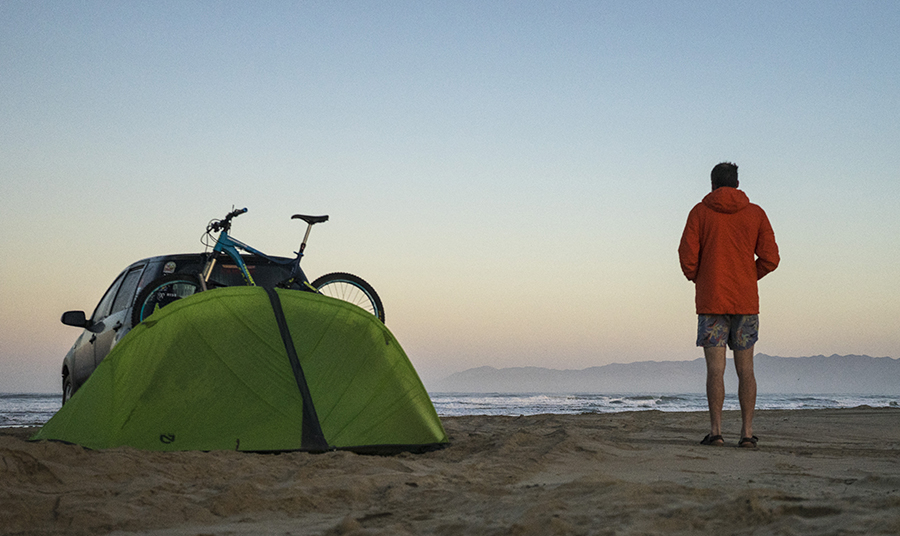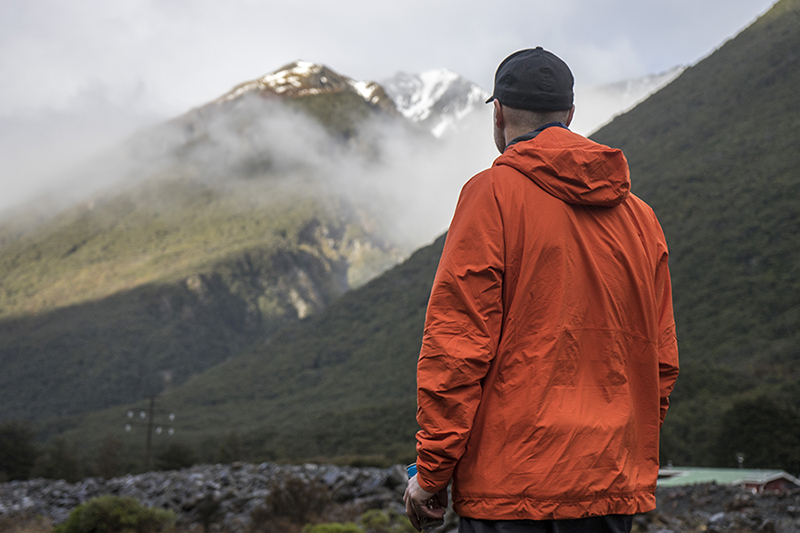
Patagonia Stretch Nano Storm Jacket
Size Tested: Large
Stated Weight: 581 g
Blister’s Measured Weight (L): 614 g
Front Zipper Length (size L): 80 cm
Stated Features:
- Articulated pattern and seamless shoulder design complement the fabric stretch for enhanced ease of movement
- Alpine helmet-compatible, 2-way adjustable hood
- Venting pit zips have waterproof, PU-coated 2-way zippers
- Self-fabric hook-and-loop cuff closures and dual-adjust Cohaesive embedded cord-lock system at hem seal out the elements
Pockets:
- 2 Zippered hand warmer pockets
- 2 Napoleon chest pockets
- 2 Internal stuff pockets
Construction:
- Shell: H2No Performance Standard shell: 2-layer, 2.2-oz 30-denier 100% nylon stretch ripstop with a waterproof/breathable barrier and a DWR (durable water repellent) finish.
- Insulation: 60-g FullRange 100% stretch polyester
- Lining: 1.3-oz 20-denier 100% nylon stretch ripstop
MSRP: $449 USD
Reviewer: 6’0”, 180 lbs
Test Locations: Grand Teton National Park, WY; Teton Canyon, Idaho; Porters Ski Area & Craigieburn Valley, NZ; Pismo Beach, CA
Days worn: 18
Intro
While Patagonia is introducing several new products this winter (e.g., the Nano-Air Light Hoody), and updating old standbys like their PowSlayer kit, one of their most hyped new products is the all-new Stretch Nano Storm Jacket. According to Patagonia, it’s a stretchy, weatherproof, breathable jacket designed to work as “a combo belay parka and storm shell in one.”
When we first saw the Stretch Nano Storm at SIA, we were intrigued, since it seemed like the sort of piece that should adapt well to a very wide range of situations and conditions. We included the Stretch Nano Storm on our review trip to New Zealand, and since then, it’s been a constant companion on just about every trip I’ve been on.
Fit
I wear a size Large in pretty much everything, and I found the Stretch Nano Storm to be cut more generously than I’d expected — it’s one of the few pieces that I could easily get away with a Medium for a more slim fit. The Nano Storm is long; its 80 cm front zipper is more reminiscent of an inbounds shell than most of the insulators I’ve used, and the arms are long enough that I haven’t had any issues with them riding up. The hood is big enough to fit over a climbing helmet well, and a ski helmet if necessary.

Overall it’s bigger than the Mountain Equipment Prophet, and fits more like a casual or inbounds piece than any climbing shell I’ve worn. That means that there is less of a gap in the rear when bending over, it looks better in a casual setting, and it mates well with Patagonia’s new Hybrid Sleeping Bag (which I’ll be reviewing soon).
Materials and Comfort
The big thing that sets the Stretch Nano Storm apart from the Mountain Equipment Prophet and other similar insulators is its soft, stretchy, quiet material. The inner liner is very reminiscent of the Nano Air, which is one of the most comfortable pieces we’ve used. Because it’s soft, the Nano Storm instantly feels warmer than a traditional puffy with a nylon liner which usually has a cold, clammy feel next to skin.
The stretch is very noticeable throughout, and is a big reason that I think I could safely size down in the Stretch Nano Storm — it’s more stretchy than any insulator I’ve used.
The shell fabric is surprisingly quiet (no loud crinkling) which makes it better suited for casual use.
Pockets
I’m a huge fan of the Stretch Nano Storm’s pocket layout. The two hand warmer pockets are nice and big, and they have a soft lining that is comfortable and feels instantly warm. The two chest pockets are similarly handy, and fit a phone or large wallet easily. The inside drop-in pockets are perfect for any device or food you need to keep warm close to your body. All the pockets have water resistant zippers, and so far I haven’t run into any issues with any zippers on the jacket.
If there’s one downside to the pocket layout it’s that there isn’t a stuff pocket; the jacket isn’t designed to pack into itself, and I’ll get into the Nano Storm’s packability in a minute.
Features
I appreciate the molded front zipper, but I’m a little apprehensive of the coil zippers on the pockets and pit zips. So far I haven’t had any issues, but I’ll report back if I do run into any problems.
The double-headed zippers on the pit vents are easy enough to activate, and the vents are long enough to really dump some heat at 16” each.
The embedded cord pulls on the hem and hood are easy to use even with gloves on, and I found the hood to be easy to adjust to a variety of hats and helmets. It lacks the wire brim of the Prophet, but it’s worked well and has caused no frustrations.
Weatherproofing
About the Stretch Nano Storm’s H2No shell, Patagonia says: “2-layer H2No Performance Standard shell fabrics are completely waterproof, windproof and breathable. They combine a water-repellent shell fabric with a waterproof/breathable membrane. They also have an internal Taffeta or mesh lining for increased durability and next-to-skin comfort.”
If you really want to dive into how waterproofing standards work and what they mean, check out our Outerwear 101 piece.

I’ve worn the Stretch Nano Storm in a few rain storms, and come away impressed. Even after some pretty heavy use in dirty conditions, it still beads water well, and once the outer DWR is overcome, I still haven’t noticed any water making it to the insulation.
That said, this is no Gore Pro shell. I would wear this as an outer layer for a season in the Tetons with no reservations, but if I was skiing in the PNW, I’d be more cautious, since the synthetic insulation is going to lose a lot of its potency as soon as the shell soaks out. For most cold weather situations, I think the H2No fabric of the Nano Storm should be more than enough, but it’s not going completely take the place of your hardshell or raincoat.
NEXT: Insulation, Breathability, Etc.

Great review. I’m curious what material Patagonia actually uses for h2no. I’ve seen some writing that it is actually made by Toray. Before I spend the money for the stretch nano I want to know exactly what type of waterproofing I’m getting. Thanks for any info.
Hey Josh, here’s Patagonia’s response: “The waterproof membrane we used in the Stretch Hydro Storm is a proprietary membrane that we developed. The H2no refers to the waterproofing standard that the membrane is rated at. Toray developed the Full Range insulation that we use in this jacket. Here is some more info on our H2No Standard: http://www.patagonia.com/h2no.html“
What would you say is a better option: this jacket or a nano-air + a shell?
Nice comet drilling into Cy’s head in the nighttime beach photo.